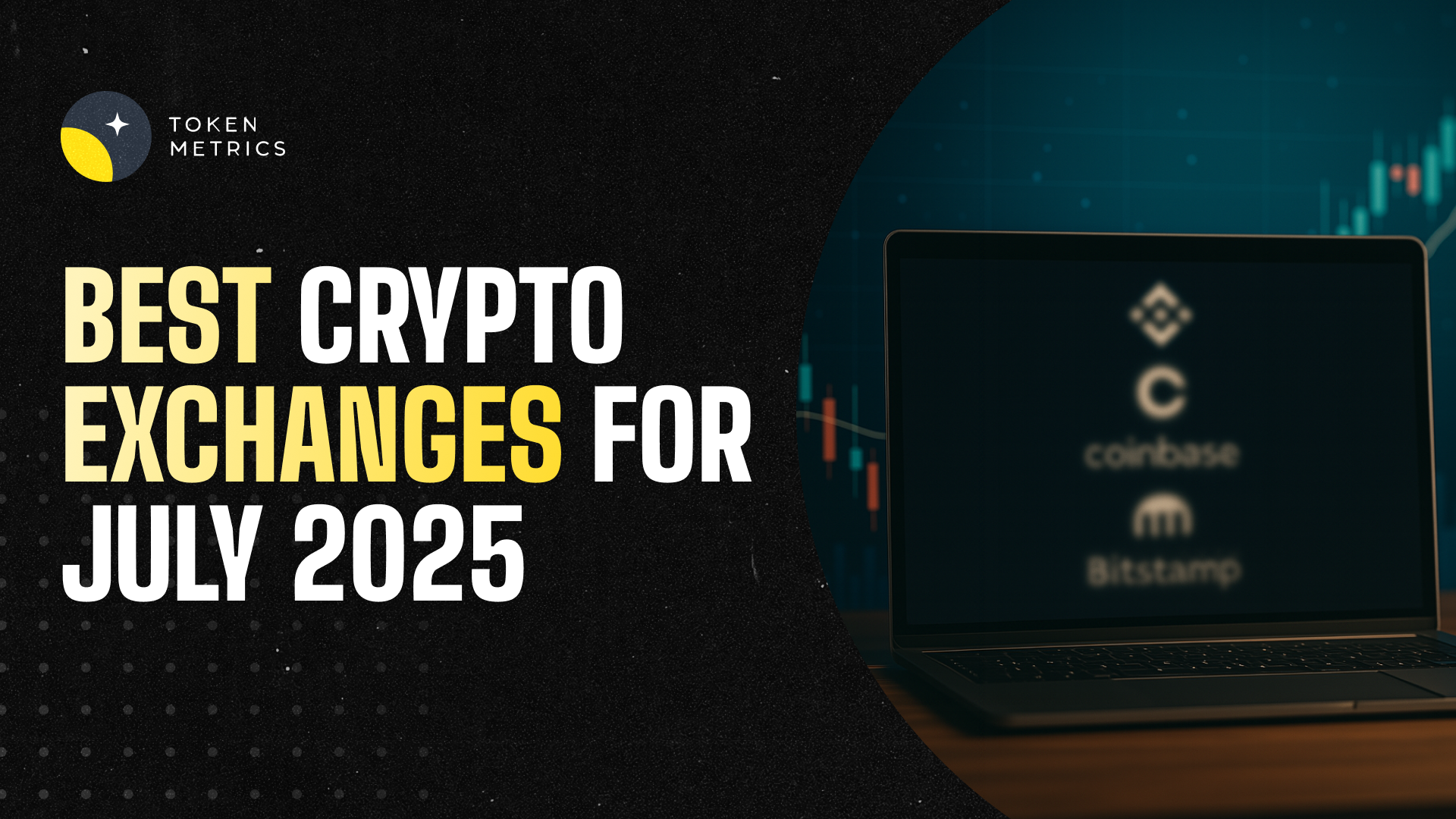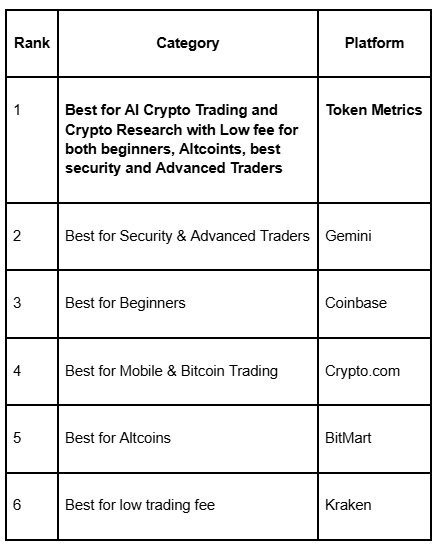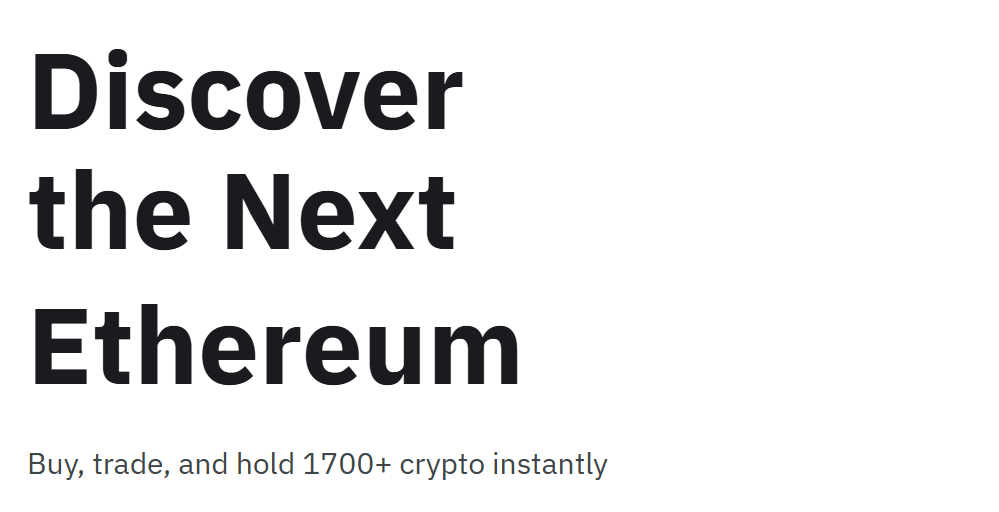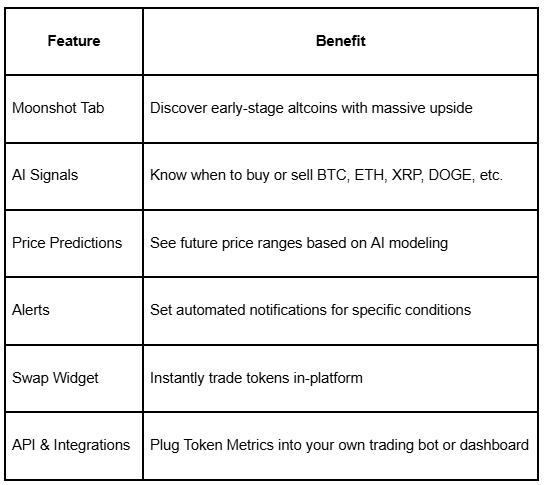
Best Crypto Exchanges for July 2025

Cryptocurrency adoption has surged in 2025, with Bitcoin reaching over $118,000 and Ethereum climbing above $3,000. Whether you’re a beginner or an advanced trader, choosing the right exchange or trading app is critical. But while exchanges handle your transactions, it’s tools like Token Metrics that give you the edge—using AI to deliver real-time analytics, trading signals, moonshot altcoin picks, and price predictions.
In this guide, we’ll cover the top exchanges and apps for July 2025, along with Token Metrics, the best platform for AI-powered crypto research and trading.
🔝 Top Crypto Platforms for July 2025

🧠 Token Metrics: Best AI Crypto Trading Platform
Token Metrics stands out not as an exchange, but as an AI-powered research, analytics, and trading platform. It gives retail and institutional investors data-driven insights to make smarter trades across any exchange.

Why Token Metrics is #1 for AI Crypto Trading:
- AI-Generated Buy/Sell Signals
Token Metrics’ signals dashboard uses over 80 data points to issue bullish or bearish calls on top tokens. For example, the AI turned bullish on Bitcoin on June 28, just before it surged past $118,000.

- Moonshots for Early-Stage Altcoins
The Moonshots tab identifies low-cap altcoins with 10x–100x potential based on momentum, AI scores, and liquidity—long before they hit mainstream exchanges.

- Price Forecasting Models
Token Metrics predicts short-, medium-, and long-term prices for major tokens. Bitcoin’s 2026 forecast, for example, ranges between $150,000–$230,000, based on ETF flows, supply on exchanges, and macroeconomic signals.

- Custom Alerts
Users can set alerts based on price, trader grade, or AI signals, delivered instantly via Email, Telegram, SMS, or Slack.

- Integrated Swap Widget
You can research, analyze, and buy tokens directly via Token Metrics’ swap widget—all in one dashboard.

Whether you’re trading on Kraken, Coinbase, or Binance, Token Metrics plugs into your strategy and helps you trade with confidence, using real-time AI insights.
⚙️ Top 5 Crypto Exchanges for July 2025
🥇 Kraken – Best for Low Fees

- Maker Fees: 0.00%–0.25%
- Taker Fees: 0.10%–0.40%
- Minimum Deposit: $10
- Crypto Offered: 300+
Kraken is ideal for fee-sensitive traders. It’s available on web, mobile, desktop, and Kraken Pro. However, it's not available in all U.S. states and lacks FDIC or SIPC insurance.
🥈 Gemini – Best for Security & Experienced Traders

- Maker Fees: 0.00%–0.20%
- Taker Fees: 0.03%–0.40%
- Minimum Deposit: $0
- Crypto Offered: 70
Gemini is the most secure exchange in 2025, with FDIC insurance, crypto insurance, and advanced features through its ActiveTrader terminal. But it has a complex fee structure and limited assets.
🥉 Coinbase – Best for Beginners

- Maker Fees: 0.00%–0.40%
- Taker Fees: 0.05%–0.60%
- Minimum Deposit: $0
- Crypto Offered: 240
Coinbase is ideal for newcomers with its clean UI, beginner-friendly tools, and educational content. It’s available in 172 countries, though advanced traders might want more features.
📱 Crypto.com – Best Mobile App & Bitcoin Trading

- Maker Fees: 0.00%–0.25%
- Taker Fees: 0.05%–0.50%
- Minimum Deposit: $20
- Crypto Offered: 417
With a sleek mobile app and support for Bitcoin options and futures, Crypto.com is perfect for on-the-go traders. However, it only supports a hot wallet and has limited global access.
🪙 BitMart – Best for Altcoins

- Fees: Varies by tier (0.04%–0.60%)
- Minimum Deposit: Not disclosed
- Crypto Offered: 1,700+
BitMart is the best place to find rare altcoins. With copy trading and BitMart Academy, it’s useful for altcoin hunters. But its lack of transparency on security is a concern.
✅ Why Token Metrics Complements These Exchanges

⚠️ Reminder: Crypto Is Risky
Crypto markets are volatile and speculative. While these exchanges and tools can improve your strategy, always do your own research (DYOR) and consult professionals when investing.
Final Thoughts
If you want to trade crypto in July 2025, pair a high-quality exchange like Kraken or Coinbase with a research powerhouse like Token Metrics. Exchanges execute trades—but Token Metrics tells you what to trade, when to trade, and why.

.svg)

Create Your Free Token Metrics Account

.png)




%201.svg)
%201.svg)


%201.svg)









.svg)




.png)